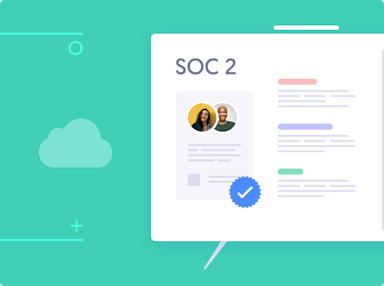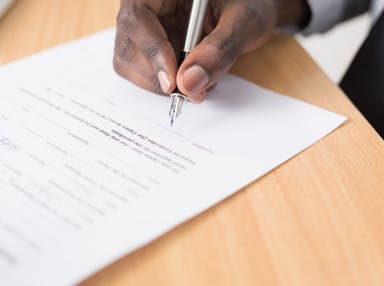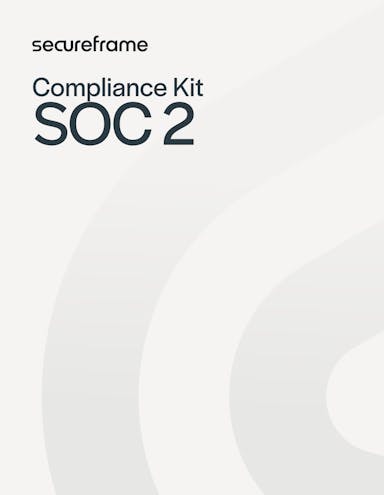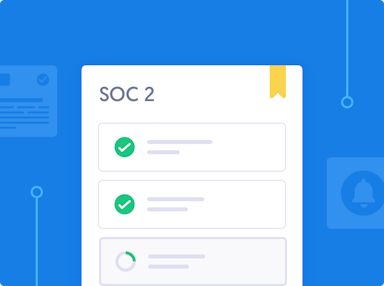
SOC 2 Explained: Understanding the Report Types, Requirements & Process [+ Free Resources]
Emily Bonnie
Senior Content Marketing Manager
Rob Gutierrez
Senior Cybersecurity and Compliance Manager, CISA, CCSK, CMMC RP
Cyberattacks targeting SaaS companies skyrocketed by 300% last year, according to Obsidian Security's 2025 SaaS Security Threat Report.
Since this surge in attacks has impacted organizations across all sectors, an airtight security posture is no longer a nice to have, it’s a must-have. One of the most popular and respected cybersecurity frameworks is SOC 2.
SOC 2 is a popular cybersecurity framework, but it’s not always easy to navigate. Between the different SOC frameworks and report types, vague terminology, and unfamiliar audit processes, it’s no wonder many companies feel overwhelmed. This guide breaks it all down in plain English, so you can understand what SOC 2 is, why it matters, and how to get audit-ready faster.
What is SOC 2?
SOC 2, short for System and Organization Controls 2, is a security framework developed by the American Institute of CPAs (AICPA). It was created to help service organizations — especially cloud-based companies — demonstrate that they can securely manage and protect customer data.
When companies talk about "getting a SOC 2," they’re referring to receiving an official report from an accredited auditor or CPA that confirms the company’s internal controls meet the requirements defined in the SOC 2 framework. These controls are based on a specific set of criteria designed to assess how well an organization safeguards information and maintains privacy, confidentiality, and operational reliability.
Unlike legal frameworks like HIPAA or GDPR, SOC 2 isn’t a regulatory requirement. However, it’s become a practical necessity for SaaS providers and other technology vendors that want to sell into regulated industries, move upmarket, or close enterprise deals.
Recommended Reading

The SOC 2 Compliance Hub
Why is SOC 2 required by some customers?
Over the past few years, SOC 2 has gone from a competitive differentiator to a standard expectation.
More customers are requesting a SOC 2 report in the early stages of the sales cycle. If you don’t have one, you may be quietly disqualified without even realizing it. Your organization will likely lose deals to compliant competitors, experience longer sales cycles, have difficulty moving upmarket, or be asked to complete lengthy security questionnaires in order to satisfy customers’ cybersecurity requirements.
A SOC report clears these roadblocks. It builds trust with customers, who know that you will safeguard their data from security breaches.
The process of getting SOC 2 compliant also unveils important insights into your organization’s systems and processes. Do you have conflicting policies or redundant software? SOC 2 encourages growing companies to build a stronger data security posture and scalable processes into their DNA. Laying a strong security foundation early on will make it much easier to close enterprise deals, prepare for an acquisition, and secure funding.
Recommended reading

Why Get a SOC 2 Report? 13 Reasons According to Real Organizations
What's the difference between SOC 1 vs 2 vs 3?
SOC 2 isn't the only security framework created by the American Institute of Certified Public Accountants. They also developed SOC 1 and SOC 3. So what’s the difference between these auditing standards?
- SOC 1 reports reports are focused on financial reporting and are relevant to organizations that impact customer accounting, such as payroll processors or claims systems, SOC 1 assures customers that their financial information is safe.
- SOC 2 reports focus on operational and security controls and are the most common option for SaaS and technology companies.
- SOC 3 is essentially a high-level version of SOC 2. They cover the same criteria but exclude the detailed descriptions of controls and results. Because they are designed for public distribution, SOC 3 reports are often shared on company websites, but they generally do not satisfy customers who need a deeper understanding of how your security program actually works.

Recommended reading

A Deeper Dive into the Differences Between SOC 1 vs SOC 2 vs SOC 3
What are the SOC 2 Trust Services Criteria?
SOC 2 audits evaluate your organization against one or more of the Trust Services Criteria, which define how you protect, manage, and monitor customer data.
They are:
- Security: How do you protect data from data breaches?
- Availability: How do you ensure data is reliably available to those who need it?
- Processing integrity: How do you verify that information assets and systems operate the way they’re supposed to?
- Confidentiality: How do you limit data access, storage, and use?
- Privacy: How do you keep sensitive information and personally identifiable information (PII) private from unauthorized access?

The criteria you select for your SOC 2 report are what your organization will be evaluated against during your audit.
Note that Security is the only TSC that’s required for every SOC 2 report. The other four TSC are optional, and you’ll decide which to include based on the type of services you provide and your customers’ demands.
Report types: SOC 2 Type 1 vs SOC 2 Type 2
There are two types of SOC 2 reports: Type I and Type II, and choosing the right one is one of the first decisions you’ll need to make.
A SOC 2 Type I report is a point-in-time assessment that evaluates whether your controls are properly designed. It’s faster to complete and often used by early-stage companies looking to respond quickly to customer requests or unblock deals.
A SOC 2 Type II report goes further. It examines not just the design of your controls, but whether they’ve been operating effectively over a set period of time, usually between three and twelve months. This makes it more rigorous and more valuable to customers evaluating your long-term security posture.

Because a SOC 2 Type I is a point-in-time report, it’s often faster and less expensive to complete than a Type II report. Some Type I audits can be completed in just a few weeks. However, if your customers are requesting SOC 2, they are most likely expecting a Type II report, which provides greater assurance of the quality of your organization’s security posture.
For organizations that need a SOC 2 report urgently, we typically recommend a Type II report with a 3-month review window. It will save you from duplicate audits and provide potential customers the level of assurance they need.

The SOC 2 Compliance Kit
Get key assets you’ll need to get your report, including a SOC 2 guidebook, customizable policy templates, readiness checklist, and more.
The SOC 2 compliance process: 5 key steps
No two SOC 2 audits are alike. Every organization is different, the chosen Trust Services Criteria are different, and the internal security controls and systems are different.
That said, SOC audits typically follow a similar set of steps. Here's a quick overview of the audit process.
Step 1: Deciding the report type and TSC
First, the organization decides which type of SOC 2 report they will pursue — a Type I or Type II — and which TSC they will include in the scope of their report. Remember, Security is the only required TSC.
Step 2: Determine the audit window for Type II audit
Next, if you’re pursuing a Type II audit, you’ll define your audit window. The AICPA recommends a minimum of six months, but many companies opt for a three-month window for their first report to speed things up.
Step 3: Preparing the documentation
Once your scope is defined, the documentation process begins. This is where you gather the evidence your auditor will need to verify that your controls are in place and functioning. Your auditor will review all of this documentation, along with your systems and security controls, to determine your level of compliance with the TSC you’ve selected.
Examples of documents your auditor will need are:
- Information asset inventories
- User access controls and policies
- Risk management policies, risk assessments, and risk treatment plans
- Change management policies and procedures
- Code of conduct and ethics policies
- Security incident response and business continuity plans
- Maintenance records and system backup logs
Step 4: Completing a gap analysis and readiness assessment
Finally, you’ll complete a gap analysis and readiness assessment. Use the documents you’ve compiled to compare where your organization stands today with SOC 2 requirements. Where are the gaps you’ll need to fill in before your audit?
A formal readiness assessment can provide useful insights into the state of your security posture. A SOC 2 auditor will perform its own gap analysis and provide specific recommendations for your organization based on the TSC you’ve selected for your audit. The final readiness assessment report will help identify which controls will appear in your final SOC 2 report and any vulnerabilities that could prevent you from meeting compliance requirements.
Step 5: Select your auditor
Finally, you’ll select an accredited CPA or auditing firm and complete your SOC 2 audit, during which the auditor will test the operating effectiveness of your systems and controls. At the end of your audit, you’ll be issued your formal report.
To maintain compliance, a new audit is typically needed every 12 months.
Recommended reading

SOC 2 Compliance Checklist for 2025: Must-Have Tips to Get SOC 2 Audit-Ready
35+ free resources to simplify SOC 2
To help make the process easier, we’ve created a SOC 2 Compliance Hub with more than 35 free resources. You’ll find customizable policy templates, audit readiness checklists, evidence spreadsheets, downloadable guides, and more. These tools are designed to help teams of all sizes understand what’s required, close security gaps, and stay organized throughout the audit process.
You can also browse our library of free SOC 2 policy templates, audit readiness checklists, evidence spreadsheets, ebooks, and more.
Streamline SOC 2 compliance with Secureframe
We've worked with thousands of organizations to make SOC 2 compliance more efficient, saving teams hundreds of hours and thousands of dollars spent writing security policies, collecting evidence, hiring security consultants, performing readiness assessments, and continuously monitoring your infrastructure for vulnerabilities and compliance issues.
In a recent survey of more than 160 small businesses, 81% of Secureframe customers said they were able to prepare for and complete audits at least 25% faster. 32% prepared for and completed an audit in less than half the time.
We even helped one customer get their SOC 2 report in just six days.
We can help you achieve similar results so you get your SOC 2 report faster and save money while strengthening your security posture.
Request a demo to learn more about how we can help you get SOC 2 compliant in weeks, not months.
Automate SOC 2
FAQs
Is SOC 2 compliance mandatory for SaaS companies?
No, SOC 2 compliance is not legally required for SaaS or any other type of company. However, many customers, especially enterprise clients, require SOC 2 reports before engaging with a SaaS company to ensure their data is secure. Without a SOC 2 report, SaaS companies may face longer sales cycles, lose deals, or need to complete extensive security questionnaires to unblock deals.
Can small businesses achieve SOC 2 compliance?
Yes, small businesses can achieve SOC 2 compliance. In fact, it is increasingly common as more customers demand SOC 2 reports. Tools like Secureframe simplify the process, helping smaller teams prepare faster and at a lower cost.
Is SOC 3 the same as SOC 2?
No, SOC 3 is a less detailed version of a SOC 2 report, designed for public sharing. While both address controls relevant to the Trust Services Criteria, SOC 3 lacks the depth of information and privacy of SOC 2, making it insufficient for most customers who require assurance about data security.
How does SOC 2 compliance benefit my organization?
SOC 2 compliance offers several advantages to your organization. It demonstrates your commitment to protecting customer data, which helps build trust with clients, differentiate yourself from competitors, and shorten the sales cycles. It also strengthens your internal security posture, making it easier to scale your business, secure funding, or prepare for acquisition.
How can Secureframe help with SOC 2 compliance?
Secureframe streamlines the SOC 2 compliance process by automating policy management, evidence collection, gap analysis, continuous monitoring, and other workflows. This saves time and money while ensuring a strong security posture. Many Secureframe customers complete their SOC 2 audits significantly faster than industry averages as a result. In fact, 95% of Secureframe users said they saved time and resources obtaining and maintaining compliance.

Emily Bonnie
Senior Content Marketing Manager
Emily Bonnie is a seasoned digital marketing strategist with over ten years of experience creating content that attracts, engages, and converts for leading SaaS companies. At Secureframe, she helps demystify complex governance, risk, and compliance (GRC) topics, turning technical frameworks and regulations into accessible, actionable guidance. Her work aims to empower organizations of all sizes to strengthen their security posture, streamline compliance, and build lasting trust with customers.

Rob Gutierrez
Senior Cybersecurity and Compliance Manager, CISA, CCSK, CMMC RP
Rob Gutierrez is an information security leader with nearly a decade of experience in GRC, IT audit, cybersecurity, FedRAMP, cloud, and supply chain assessments. As a former auditor and security consultant, Rob performed and managed CMMC, FedRAMP, FISMA, and other security and regulatory audits. At Secureframe, he’s helped hundreds of customers achieve compliance with federal and commercial frameworks, including NIST 800-171, NIST 800-53, FedRAMP, CMMC, SOC 2, and ISO 27001.